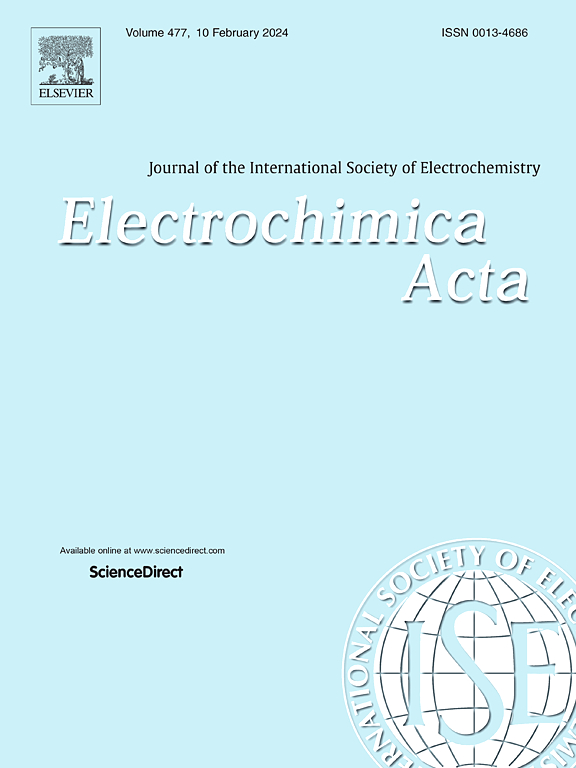Enhanced pseudocapacitive performance of transition metal doped MoO3 nanorods
IF 5.5
3区 材料科学
Q1 ELECTROCHEMISTRY
引用次数: 0
Abstract
Rising energy demands from rapid technological advancements drive the development of high-performance devices, with supercapacitors playing a key role due to their fast charge-discharge capabilities. Research on metal-doped transition metal oxides seeks to enhance energy storage efficiency, charge-discharge rates, and long-term stability, improving electrochemical performance and scalability. The present work explored the impact of metal doping on the electrochemical performance of molybdate nanoparticles, aiming to enhance specific capacitance and rate capabilities. We synthesized pure MoO3 and Fe-, Co-, and Ni-doped MoO3 nanorods using a hydrothermal method, varying doping concentrations (α = 2 %, 4 %, 6 %, 8 %). Extensive characterization was conducted, including X-ray diffraction (XRD), electron microscopy (SEM, TEM), cyclic voltammetry (CV), galvanostatic charge-discharge (GCD), and electrochemical impedance spectroscopy (EIS), highlighting the effects of dopants and their concentrations. XRD confirmed the formation of pure MoO3, Fe-, Co-, and Ni-doped MoO3 with monoclinic phases and crystallite sizes of 48.9 nm, 40.6 nm, 39.7 nm, and 25.6 nm, respectively. Nickel-doped MoO3 (NMO) exhibited nanorod morphology, increasing active sites and surface area for high-rate electrochemical reactions. NMO demonstrated outstanding electrochemical performance, achieving 167.95 F/g at 0.5 A/g and 99.79 % retention over 15,000 cycles at 12 A/g. A 6 % doping concentration significantly enhanced electrochemical properties, particularly with nickel, making NMO for supercapacitors, meeting the rising demands in energy storage solutions.
增强掺杂过渡金属的 MoO3 纳米棒的伪电容性能
快速技术进步带来的能源需求增长推动了高性能设备的发展,其中超级电容器因其快速充放电能力而发挥着关键作用。有关掺杂金属的过渡金属氧化物的研究旨在提高储能效率、充放电速率和长期稳定性,改善电化学性能和可扩展性。本研究探讨了金属掺杂对钼酸盐纳米粒子电化学性能的影响,旨在提高比电容和速率能力。我们采用水热法合成了纯 MoO3 以及掺杂铁、钴和镍的 MoO3 纳米棒,并改变了掺杂浓度(α = 2%、4%、6%、8%)。研究人员进行了广泛的表征,包括 X 射线衍射 (XRD)、电子显微镜 (SEM、TEM)、循环伏安法 (CV)、电静态充放电 (GCD) 和电化学阻抗光谱 (EIS),突出了掺杂剂及其浓度的影响。XRD 证实了纯 MoO3、Fe-、Co- 和 Ni- 掺杂 MoO3 的形成,它们具有单斜相,结晶尺寸分别为 48.9 nm、40.6 nm、39.7 nm 和 25.6 nm。掺镍氧化锰(NMO)呈现纳米棒形态,增加了活性位点和表面积,有利于高速电化学反应。NMO 表现出卓越的电化学性能,在 0.5 A/g 时可达到 167.95 F/g,在 12 A/g 时可在 15,000 次循环中保持 99.79%。6% 的掺杂浓度显著增强了电化学性能,尤其是镍的电化学性能,使 NMO 成为超级电容器,满足了能源存储解决方案不断增长的需求。
本文章由计算机程序翻译,如有差异,请以英文原文为准。
求助全文
约1分钟内获得全文
求助全文
来源期刊

Electrochimica Acta
工程技术-电化学
CiteScore
11.30
自引率
6.10%
发文量
1634
审稿时长
41 days
期刊介绍:
Electrochimica Acta is an international journal. It is intended for the publication of both original work and reviews in the field of electrochemistry. Electrochemistry should be interpreted to mean any of the research fields covered by the Divisions of the International Society of Electrochemistry listed below, as well as emerging scientific domains covered by ISE New Topics Committee.
 求助内容:
求助内容: 应助结果提醒方式:
应助结果提醒方式:


